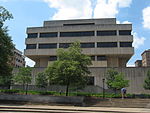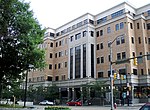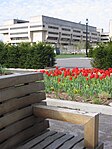Bouquet Gardens

Bouquet Gardens is a major student residential complex of the University of Pittsburgh consisting of eight, 4-story garden-style gabled-roofed apartment buildings (Buildings A through H) clustered around progression of courtyards connected by an interior pathway as well as a four-story apartment-style residence hall (Building J). Each gabled-roofed apartment-style building contains sixteen 4-bedroom apartments while the 155 bed Building J contains amenities for use by residents of the entire complex.[1] Designed by Renaissance 3 Architects, P.C.[2], the combined complex houses 651 upper-level undergraduate students in 172 units located on the lower campus close to Posvar Hall, the Barco Law Building, and adjacent to Sennott Square.
Excerpt from the Wikipedia article Bouquet Gardens (License: CC BY-SA 3.0, Authors, Images).Bouquet Gardens
Oakland Avenue, Pittsburgh
Geographical coordinates (GPS) Address Nearby Places Show on map
Geographical coordinates (GPS)
| Latitude | Longitude |
|---|---|
| N 40.440863 ° | E -79.955351 ° |
Address
Bouquet Gardens Building H
Oakland Avenue
15260 Pittsburgh
Pennsylvania, United States
Open on Google Maps







